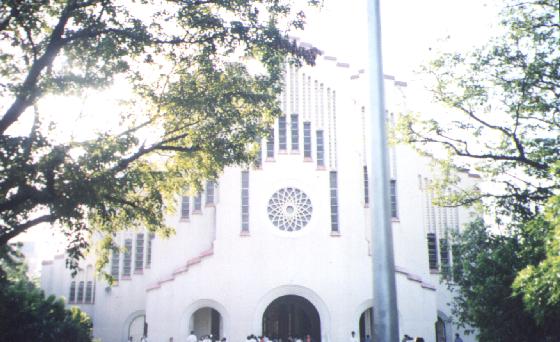

Byzantine architecture combined the artistry of Greece, structural engineering of Rome and the color of the East. The dominant character of the Byzantine architecture is the dome. This was used to cover a square or a polygonal plan giving also a vertical composition of the buildings erected during this period. The Adamson church is located near United Nations Ave. The dome of this church gives a vertical impression for the eye is gradually drawn upwards toward the central culminating dome. The Redemptorist Church in Baclaran is also a good example of the Byzantine structure. Like most Byzantine churches, the Redemptorist church has no campanille or bell tower.


Gothic architecture is without doubt one of the most brilliant inventions of the Western spirit, even though it constitutes a kind of parenthesis in the history of form. Without precedent in the ancient wold, it had no successor, even if one takes account of its brief revival during the nineteenth century. It began to affect Western Europe in the 12th century, spread to the Holy Roman Empire and central Europe the following century, to some extent pushed its way into the countries conquered by the Crusades, and even spread into the Scandinavian countries. Italy alone remained relatively unaffected, pursuing other directions which were to transform architecture more permanently . In some countries, Gothic architecture was to rule for three centuries or more until, at the end of the 16th century, France, England, Spain and the Holy Roman Empire hesitated before adopting the new language of the Renaissance. Here in the Philippines, one of the most magnificent churches is inspired by Gothic architecture. The San Sebastian church, with its prominent spire standing majestically is also known as the only church in the Philippines that is made of steel. You can find it right in the middle of University Belt in Claro M. Recto. The San Beda church on the other hand, has a less decorated spire and two towers connected by a colonnaded structure.
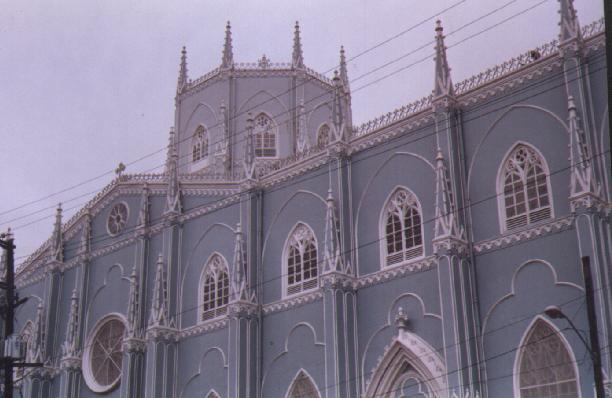

Reacting
against the architecture of late antiquity and the early Middle Ages, the
Romanesque period embarked on a number of experiments which,
in spite of obvious local variations, indicated a definite sense of
cohesion. As always in religious architecture, this universal approach
was conditioned both by necessities and by liturgical demands, which had
a strong bearing on the evolution of forms. During the Romanesque
era, the building was very much the product of the ceremonial
conducted within its walls; consequently, a number of new features emerged,
firstly in respect of the ground plan, subsequently in respect of elevation.
In the Philippines, the Manila Cathedral is considered as one of the most
beautiful churches that was ever built. The main features are
the arched recessed doorways ornamented by sculptures. The general
architectural character of the Romanesque which is sober and dignified
is reflected on this church.
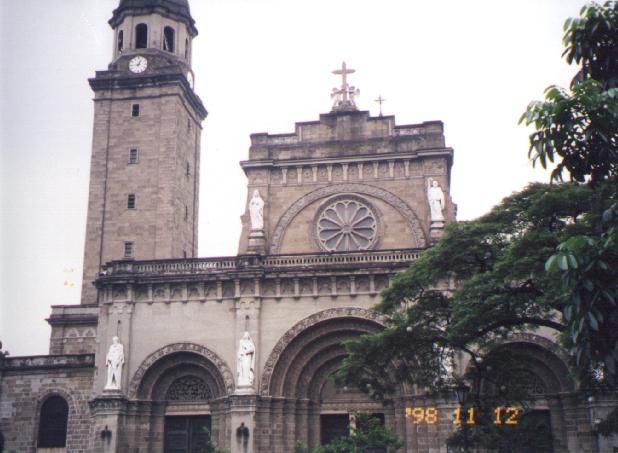
The
history of Renaissance architecture coincides only partially with
that of European architecture as a whole in the 15th and 16th centuries.
Far from showing the signs of exhaustion, Gothic architecture, which its
contemporaries called “modern”, continued to produce new masterpieces.
At the same time the “antique” style which had appeared in Florence at
the beginning of the 14th century spread through Italy and, during the
course of the 16th century, throughout Europe (though not without resistance).
Historians, instead of attempting to generalize the history of European
architecture in the 15th and 16th centuries, have juxtaposed two distinct
histories: one traces what in retrospect appear as the last manifestations
of the Gothic style; the other, the progress of the new style, the architectural
expression of which has been known since the 19th century as the Renaissance.
The San Augustin church in Intramuros can be classified as Renaissance
in architecture. The corinthian capital which is a classic
form can be found in the façade of the church.
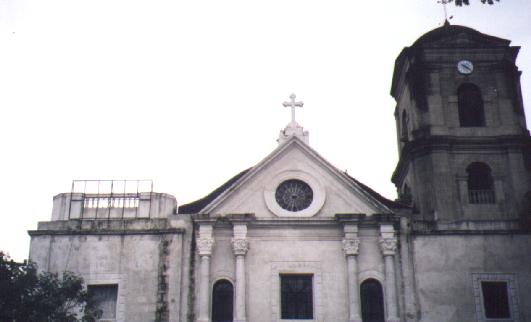
The division of history into centuries is an artificial device. Sometimes useful, often misleading, it can become ludicrous to try to force the history of an idea into the span of a century. Even when we take an overall look at the history of European architecture, it is impossible to sum up the 17th century as the age of the Baroque, succeeding Renaissance and Mannerism, or even as the age in which classical and Baroque opposed each other, without severely distorting the facts. It is useful to remember the history of the word “Baroque”. It was originally a term used by jewellers to describe irregularly shaped pearls. From this precise, technical meaning (the only one given in Furetiere’s dictionary of 1690) was derived the figurative sense of “irregular” or “bizarre” listed in the dictionary published by the French Academy in 1718. The word was used in this latter sense during the second half of the 18th century to describe all those idiosyncratic architecture forms so abhorred by current academic taste and by Neoclassical rationalism: it was applied to Gothic tracery; to the overlapping, broken pediments of Pietro da Cortona and Carlo Rainaldi; to the complex geometry of Francesco Borromini; to Guarino Guarini’s domes; and to Rococo ornament. Here “Baroque” did not describe a specific age or style, but referred to any irregular form which – according to the definition given in Antoine Joseph Pernety’s Dictionaire des beaux-arts (1757) – “follow not the proportional norms but the caprice of the artist”.
The St. James Cathedral
in Ayala Alabang can be considered as an architecture that was inspired
by the Baroque period. Fascinating to note that the dome has a lantern
that reminds one of the Santa Maria della Salute in Venice.
The Madrigal church also in Alabang is Baroque
inspired.
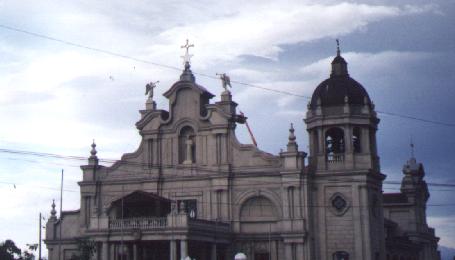
The
art of
Islam seems familiar enough to the Westerner, who might well feel
he knows its essential qualities and has a clear picture of it based on
direct observation. But as soon as he tries to give those qualities
precise definition the impression dissolves. Taking buildings alone,
and thinking for example of the various forms of mosque, all sense of consistency
disintegrates. What does an Ottoman mosque in Istanbul have in common
with the great mosque of Cordoba? In the effort to discover the essence
of Islamic architecture, good number of obstacles arise. We
are dealing with a world which is still alive and changing , so much so
that its present appearance can obscure 15 centuries of constant evolution.
In the Philippines, the
Manila Golden Mosque located in the Muslim community of Quiapo. The
dome that is shaped like a bulb reminds us of the Dome of the Rock in Ravenna.
One of the characteristics of the Islam architecture which is the crescent
moon can be seen even from a distance. The Indian Sikh temple on
the other hand is less decorated and much simpler in design. However,
the onion bulb dome is still present.
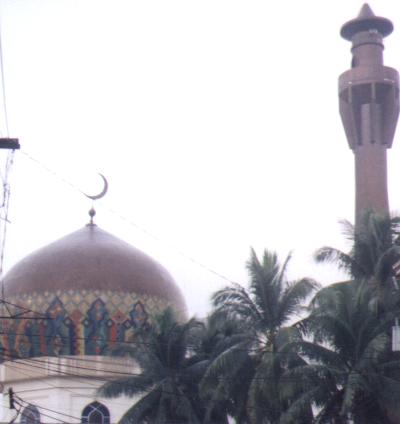
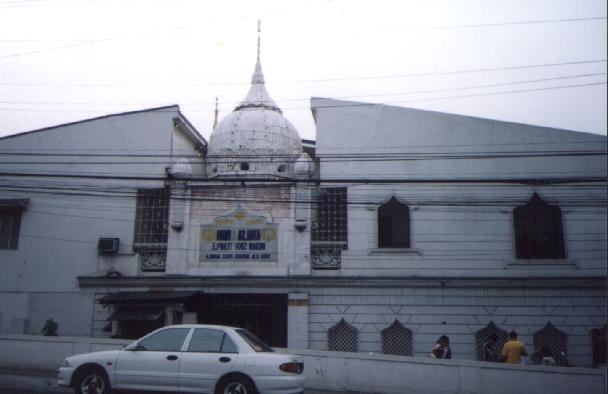
Sourced from The World Atlas of Architecture